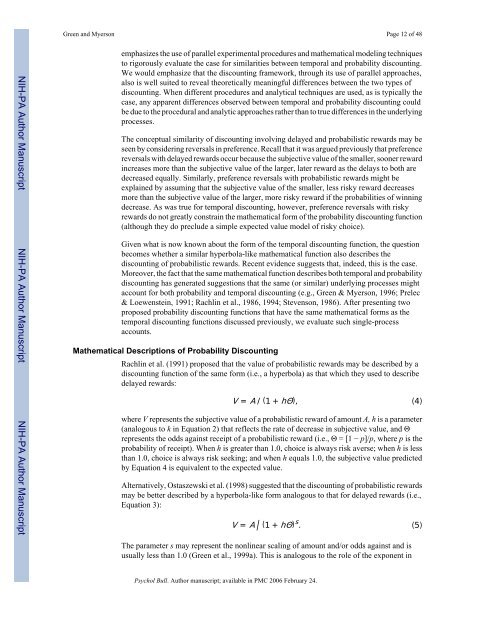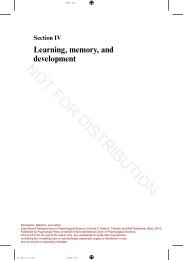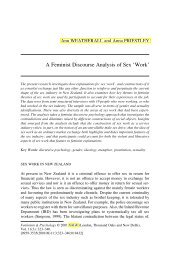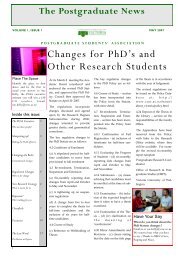green & myerson 2004.. - of /courses
green & myerson 2004.. - of /courses
green & myerson 2004.. - of /courses
You also want an ePaper? Increase the reach of your titles
YUMPU automatically turns print PDFs into web optimized ePapers that Google loves.
Green and Myerson Page 12 <strong>of</strong> 48<br />
NIH-PA Author Manuscript NIH-PA Author Manuscript NIH-PA Author Manuscript<br />
emphasizes the use <strong>of</strong> parallel experimental procedures and mathematical modeling techniques<br />
to rigorously evaluate the case for similarities between temporal and probability discounting.<br />
We would emphasize that the discounting framework, through its use <strong>of</strong> parallel approaches,<br />
also is well suited to reveal theoretically meaningful differences between the two types <strong>of</strong><br />
discounting. When different procedures and analytical techniques are used, as is typically the<br />
case, any apparent differences observed between temporal and probability discounting could<br />
be due to the procedural and analytic approaches rather than to true differences in the underlying<br />
processes.<br />
The conceptual similarity <strong>of</strong> discounting involving delayed and probabilistic rewards may be<br />
seen by considering reversals in preference. Recall that it was argued previously that preference<br />
reversals with delayed rewards occur because the subjective value <strong>of</strong> the smaller, sooner reward<br />
increases more than the subjective value <strong>of</strong> the larger, later reward as the delays to both are<br />
decreased equally. Similarly, preference reversals with probabilistic rewards might be<br />
explained by assuming that the subjective value <strong>of</strong> the smaller, less risky reward decreases<br />
more than the subjective value <strong>of</strong> the larger, more risky reward if the probabilities <strong>of</strong> winning<br />
decrease. As was true for temporal discounting, however, preference reversals with risky<br />
rewards do not greatly constrain the mathematical form <strong>of</strong> the probability discounting function<br />
(although they do preclude a simple expected value model <strong>of</strong> risky choice).<br />
Given what is now known about the form <strong>of</strong> the temporal discounting function, the question<br />
becomes whether a similar hyperbola-like mathematical function also describes the<br />
discounting <strong>of</strong> probabilistic rewards. Recent evidence suggests that, indeed, this is the case.<br />
Moreover, the fact that the same mathematical function describes both temporal and probability<br />
discounting has generated suggestions that the same (or similar) underlying processes might<br />
account for both probability and temporal discounting (e.g., Green & Myerson, 1996; Prelec<br />
& Loewenstein, 1991; Rachlin et al., 1986, 1994; Stevenson, 1986). After presenting two<br />
proposed probability discounting functions that have the same mathematical forms as the<br />
temporal discounting functions discussed previously, we evaluate such single-process<br />
accounts.<br />
Mathematical Descriptions <strong>of</strong> Probability Discounting<br />
Rachlin et al. (1991) proposed that the value <strong>of</strong> probabilistic rewards may be described by a<br />
discounting function <strong>of</strong> the same form (i.e., a hyperbola) as that which they used to describe<br />
delayed rewards:<br />
V = A / (1 + hΘ), (4)<br />
where V represents the subjective value <strong>of</strong> a probabilistic reward <strong>of</strong> amount A, h is a parameter<br />
(analogous to k in Equation 2) that reflects the rate <strong>of</strong> decrease in subjective value, and Θ<br />
represents the odds against receipt <strong>of</strong> a probabilistic reward (i.e., Θ = [1 − p]/p, where p is the<br />
probability <strong>of</strong> receipt). When h is greater than 1.0, choice is always risk averse; when h is less<br />
than 1.0, choice is always risk seeking; and when h equals 1.0, the subjective value predicted<br />
by Equation 4 is equivalent to the expected value.<br />
Alternatively, Ostaszewski et al. (1998) suggested that the discounting <strong>of</strong> probabilistic rewards<br />
may be better described by a hyperbola-like form analogous to that for delayed rewards (i.e.,<br />
Equation 3):<br />
V = A / ( 1 + hΘ) s . (5)<br />
The parameter s may represent the nonlinear scaling <strong>of</strong> amount and/or odds against and is<br />
usually less than 1.0 (Green et al., 1999a). This is analogous to the role <strong>of</strong> the exponent in<br />
Psychol Bull. Author manuscript; available in PMC 2006 February 24.






